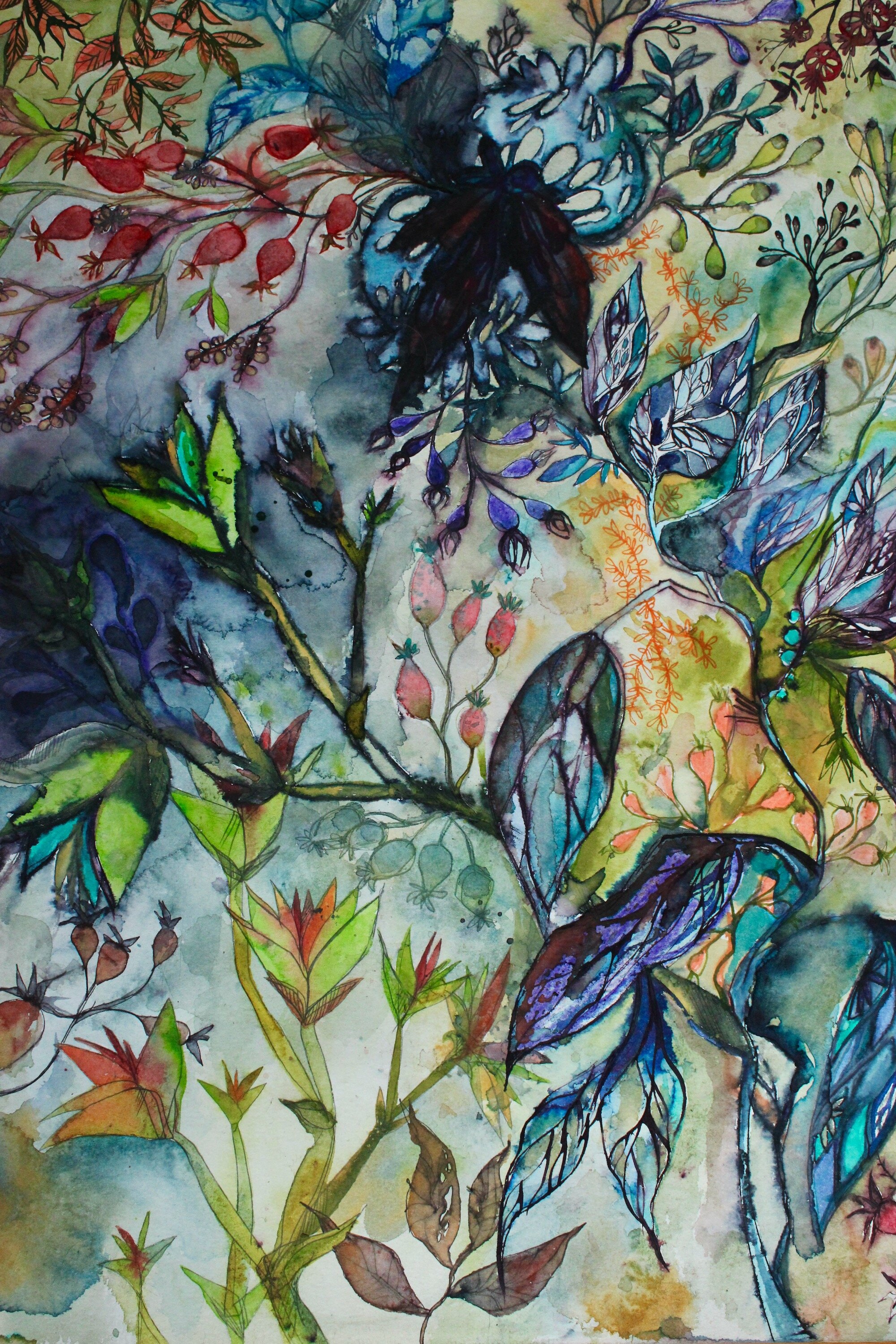The Imagination Gap
Nora Kovats. Tangled Phone Conversations. 2019-2020. Watercolour and ink painting on Hahnemühle aquarelle paper. This painting will be available as a postcard soon. Copyright © Nora Kovats.
As I delve into this imaginary botanical space I’m creating, I keep asking myself: “How much of this is a reflection of a reality I observed, and how much is purely invented? Is anything actually truly invented? Can anything be depicted as it is? How does the imagination actually work?” Part of the reason my tangled botanical explorations strike such a chord with people, I suspect, is precisely the fact that they are familiar, there’s a sense of a landscape, a framework, a setting. Those shapes I use are archetypical botanical echos that have been written into our Genes since hunter-gatherer days, and yet, my work is also strange, new, and re-composed in surprising ways.
Nora Kovats. Of Untamed Gardens & Thoughts. 2019-2020. Watercolour, graphite, wax and ink painting on Hahnemühle aquarelle paper. This painting will be available as a postcard soon. Copyright © Nora Kovats.
I recently read a biography of one of my favourite female scientific artists: Maria Sybilla Merian (1647-1717). Based in Frankfurt am Main, Nürnberg and later Amsterdam, was a an influential etymologist, botanist, copperplate artist and explorer of the 17th and early 18th century. She found her way into art in her (step-)father’s etching workshop, partly through stubborn determination and partly because no-one was better suited to take over the business once her stepfather passed away, although, as a woman in Southern Germany at that time, she had no business being independent in any way. She became particularly famous for her butterfly and moth studies, and later, when she lived in Amsterdam, for travelling to Suriname to study tropical butterflies.
Jacob Marrel: Bildnis der Maria Sibylla Merian, 1679 (Kunstmuseum Basel).
I’ve always found the chaos of the 17th century particularly compelling. Political, scientific and religious ideas were turned completely upside down multiple times and interwoven in the most fascinating way. While ancient knowledge was still revered, society struggled to reconcile it with new scientific discoveries. Ideas we now consider to be scientific truths were ridiculed, while theological doctrines were hallowed as unquestionable, sacred knowledge. While half the Western world believed the ancient Greek postulation that ‘vermin’, critters like insects, worms and small reptiles, were the devil’s creatures born from poisonous mud, Merian observed caterpillars turning into butterflies and dared to suggest that worms were ‘God’s creatures’ too. While some supported her work, others suggested that her research was blasphemous and that she was associated with the devil.
My grandfather has a stunningly hand-coloured reprinted compilation of Merian’s Metamorphosis insectorum Surinamensium. I remember being allowed to look, but never touch, although I yearned to run my eight-year-old fingers over those incredibly fine etched lines and the reds and oranges bleeding into one another. I also remember my grandfather remarking, with a somewhat regrettable shrug, that unfortunately, Merian’s work wasn’t that scientific at all, that she had used her imagination quite a bit (as if that was somehow inferior to copying something that was before your eye), that she had fused plants and animals into aesthetically pleasing compositions. While Maria Sybilla Merian meticulously observed her subjects and did render them faithfully, her plates are all very deliberately structured compositions that reflect a sort of artificial order, imposed on the world she saw. I was left a little crestfallen, since it sounded to me as if that somehow devalued her life’s work.
Title page of Maria Sybilla Merian’s most famous work Metamorphosis insectorum Surinamensium.
Maria Sybilla Merian. Illuminated copper-engraving from Metamorphosis insectorum Surinamensium, Plate XXVII. Musa paradisiaca, 1705.
Maria Sybilla Merian. Illuminated copper-engraving from Metamorphosis insectorum Surinamensium, Plate LX. 1705.
Now, of course, I admire her work for exactly those reasons: Forging one’s own cross-disciplinary path somewhere between existing categories seems very appealing from a 21st century view. I love that idea of merging the outer and inner world to compile a new reality. It’s my own approach to my work.
I have become very interested in exactly that fusion of art and science, the interlocking of objective observation and subjective interpretation. Many people believe that, by definition, one of these viewpoints has to exclude the other to exist. I know people in both camps, but, because of my education in academic art, I know many who believe that everything is only a subjective experience and there is no actual truth that matters in life. I honestly think that’s quite problematic; I suppose I’m not a great fan of post-modernism because it strips our world of meaning.
But both of these modalities exist in our world at the same time – actually, I believe that they have to coexist for us to explain reality in any satisfactory way. To me, that gap between these seemingly unreconcilable approaches to the search for knowledge is spanned by imagination. Scientists need imagination to think of possible solutions to physical problems, artists need imagination to articulate their inner experience of the world. Humans need imagination to empathize, to solve problems, to have hope in unbearable circumstances, to achieve goals. Imagination is fuel for desire, imagination is glue to harmonize paradoxes. Imagination breeds enthusiasm, and cultivates meaning. Imagination truly is a gift that needs to be cultivated.
When I think of a way forward in this world of ours, a way to bridge squabbles and connect opposites and make space for crazy new ideas, imagination is key. We need to leave a little room for us to be surprised, to be awed. We need to make space for that inner garden to grow into something meaningful, hedged by meticulous questioning on one side and aesthetic meanderings on the other.
Nora Kovats. Expedition. 2020. Watercolour and ink painting on Hahnemühle aquarelle paper. This painting will be available as a postcard soon. Copyright © Nora Kovats.






